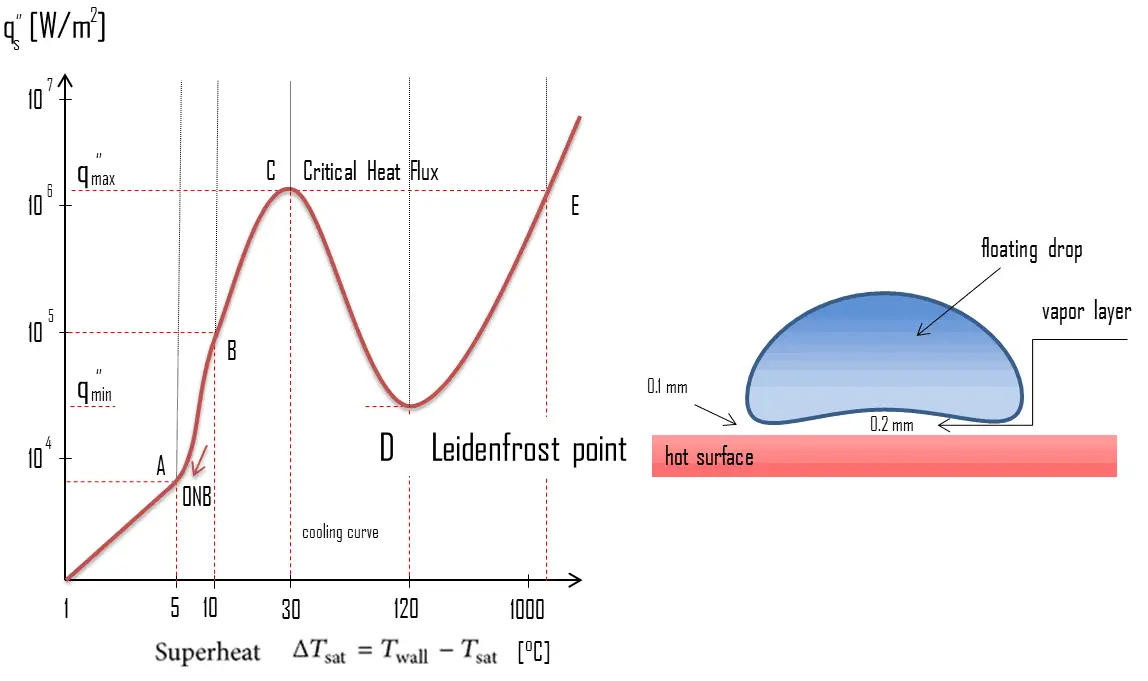Minimum Heat Flux – Quenching – Departure from Film Boiling
 The Leidenfrost point, which corresponds to the minimal heat flux, is of practical interest since it represents the lower limit for the heat flux in the film boiling regime. If the heat flux drops below this minimum, the film will collapse, causing the surface to cool and nucleate boiling to be reestablished. Therefore, at this point, return to nucleate boiling (RNB) occurs. The terms quenching, minimum heat flux, return to nucleate boiling, departure from film boiling, film boiling collapse, and Leidenfrost point have been used interchangeably to refer to various forms of rewetting, but they are not exactly synonymous.
The Leidenfrost point, which corresponds to the minimal heat flux, is of practical interest since it represents the lower limit for the heat flux in the film boiling regime. If the heat flux drops below this minimum, the film will collapse, causing the surface to cool and nucleate boiling to be reestablished. Therefore, at this point, return to nucleate boiling (RNB) occurs. The terms quenching, minimum heat flux, return to nucleate boiling, departure from film boiling, film boiling collapse, and Leidenfrost point have been used interchangeably to refer to various forms of rewetting, but they are not exactly synonymous.
Using the stability theory, Zuber derived the following expression for the minimum heat flux (and corresponding Leidenfrost point) for a large horizontal plate:
where
- qmin – minimal heat flux [W/m2]
- hfg – enthalpy of vaporization, J/kg
- g – gravitational acceleration m/s2
- ρl — density of the liquid kg/m3
- ρv — density of vapour kg/m3
- σ — surface tension-liquid-vapour interface N/m
Leidenfrost Effect
The Leidenfrost effect is a physical phenomenon in which a liquid, in near contact with a mass significantly hotter (e.g. a water drop in a hot pan) than the liquid’s boiling point, produces an insulating vapor layer keeping that liquid from boiling rapidly. The fact that a water drop is long lived when deposited on metal that is much hotter than the boiling temperature of water was first reported by Hermann Boerhaave in 1732. It was not investigated extensively until 1756 when a German doctor Johann Gottlob Leidenfrost published ‘‘A Tract About Some Qualities of Common Water.’’
This effect is can be commonly demonstrated during cooking when one sprinkles drops of water in a pan to gauge its temperature: if the pan’s temperature is at or above the Leidenfrost point, the water skitters across the pan and takes longer to evaporate than in a pan below the temperature of the Leidenfrost point (but still above boiling temperature). The Leidenfrost point, which corresponds to the minimal heat flux, is of practical interest since it represents the lower limit for the heat flux in the film boiling regime. If the heat flux drops below this minimum, the film will collapse, causing the surface to cool and nucleate boiling to be reestablished. The Leidenfrost effect is also responsible for the ability of liquid nitrogen to skitter across floors.
We hope, this article, Minimum Heat Flux – Quenching – Departure from Film Boiling, helps you. If so, give us a like in the sidebar. Main purpose of this website is to help the public to learn some interesting and important information about thermal engineering.

